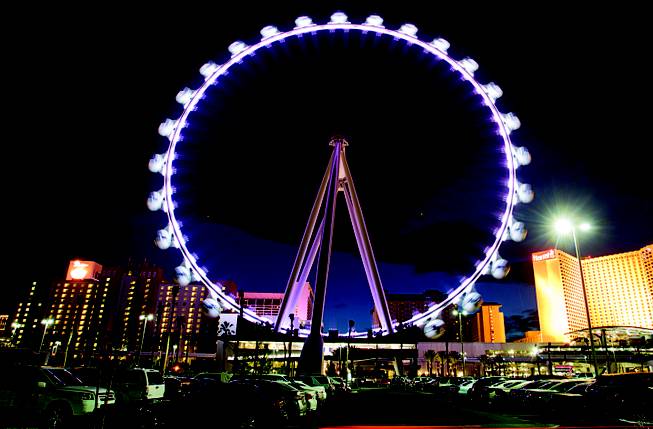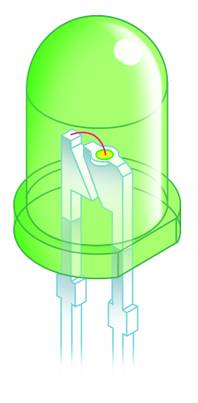
The High Roller.
Monday, Dec. 22, 2014 | 2 a.m.
They light up living rooms, street lights and Christmas trees.
LEDs, or light-emitting diodes, may not look like much, but the little lights recently earned three scientists the Nobel Prize in Physics.
The Japanese scientists invented a blue diode lamp that when coated with phosphorus or combined with red and green LEDs makes it possible to create white LED lamps.
Red and green LEDs have existed for decades, but blue LEDs — with the highest visible frequencies and the only LEDs that can be converted into white light, the best for illuminating the interiors of homes and offices — were elusive until the ‘90s.
What makes the scientists’ discovery Nobel-worthy? The increased efficiency of white LEDs has meant inexpensive, sustainable lighting, here and abroad.

Though more expensive to buy than incandescent bulbs, LED lights save energy, last longer and are as bright or brighter than traditional electric lighting, saving money both on energy and replacement costs.
In the developing world, the bulbs’ low power requirement allows them to be operated cheaply by solar power. The Royal Swedish Academy of Science, which awards the Nobel prize, estimates LED lamps have the potential increase the quality of life for more than 1.5 billion people around the world who don’t have access to the electricity grid.
How they work
Think of LEDs as tiny light bulbs that fit easily into electrical circuits. The biggest difference from standard incandescent bulbs is they don’t have a central filament that burns out. Instead, light is produced by electrons that move along a semiconductor.
It’s a much more efficient process and takes less energy to produce light. That’s why LEDs typically are much cooler to the touch than traditional light bulbs and much safer as a result.
The breakthrough
A blue LED was difficult to create because scientist struggled growing a material that would emit a short enough wavelength to produce blue light. Red diodes emit long wavelengths and green diodes medium ones.
Mixing the three colors — red, green and blue — produces white light.

What they’re used for
Because of their small size, LEDs can be clustered and used for most of the same purposes as incandescent bulbs. LEDs also have many uses that surpass incandescents. For example, LEDs have replaced traditional tubes in televisions, allowing for super-thin flat screens.
Other common uses include:
Lamps and space lighting
Digital clocks
Remote controls
Christmas lights
Freeway exit signs
Street lights
Traffic lights
Aviation lighting
Automotive head lamps
The origin of LEDs
The first LED was created in 1927, though the bulbs weren’t used commercially until 1962, when red and infrared LEDs were invented and used to power remote controls and display digital numbers on appliances.
Yellow and green LEDs arrived the following decade, but white LEDs remained elusive until the invention of the blue diode in the 1990s. The blue LED also proved essential for developing LED-powered floor lamps, computer screens and televisions.
Are they expensive?
Not anymore. Recent price drops because of increased competition among manufacturers and greater consumer demand has made LEDs much more cost effective for utilities and far cheaper for consumers.
In 2012, LEDs averaged $30 to $40 each; today they cost $9 to $10. NV Energy offers an instant rebate that puts them at $4 to $5.
Even better, because they last much longer, LEDs cost 70 to 80 percent less over their lifespan than incandescent bulbs.
Simple Savings
NV Energy runs a Simple Savings program that lowers customer’s costs when they buy qualifying LEDs at participating retailers. The program, one of the only strictly-LED savings programs in the country, was designed to encourage people to buy LED products, which can be slightly more expensive up front but are more cost effective for both customers and utilities in the long run.
To find a store where Simple Savings discounts apply, visit nvenergy.com/lighting.
Among the types of LED lighting covered by the instant rebates:
* A-line fixtures for wall sconces, table lamps.
* Reflectors for recessed, track, spot, flood and can lighting.
* MR16s, to replace halogen MR16s, for crevice lighting under cabinets and range hoods.
Who uses them locally?
Most major casino companies, including MGM Resorts International and Caesars Entertainment use LEDs, from hotel room lighting at MGM Grand to 2,000 diodes that illuminate the High Roller at the Linq.
The city of Las Vegas installed about 30,000 LEDs on city streetlights over the past two years.
Flying into McCarran International Airport, it appears there’s a line that runs through the city of Henderson. On one side, the lights glow yellow. On the other, white-blue.
The white-blue lights aren’t LEDs; they’re energy-efficient induction lighting. Henderson officials began switching over the city’s 26,000 street lights in 2010.
The induction bulbs are estimated to use 30 to 60 percent less energy and last four times longer — up to 20 years — than the amber-colored high pressure sodium lights previously used.
The city expects to save more than $800,000 annually thanks to the new technology.

Join the Discussion:
Check this out for a full explanation of our conversion to the LiveFyre commenting system and instructions on how to sign up for an account.
Full comments policy